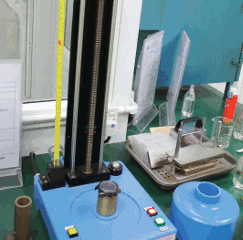On a sunny afternoon in Poole’s Dorset Lake Shipyard Ian Elliot, co-founder of watch brand Elliot Brown, is dangling from a crane.
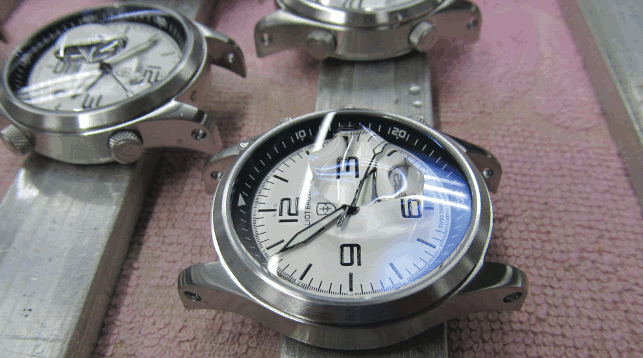
Dropping water onto the heated face of the watches to test whether any condensation forms inside
He is filming a video to showcase the strength of his watches as the critical link is a single timepiece with a stainless steel strap. Elliot hangs in the air grinning and kicking his feet about. He’s not a big chap but it shows that his watches mean business.
It also proves the simple goal that this new company had – engineer and build the toughest watches possible.
As Elliot’s fellow co-founder, Alex Brown, says, “Our aim was to do one thing and to do it properly”

Alex Brown, co-founder and horologist
This is a tall order in anyone’s book but these two bring a wealth of experience with them. Elliot invented the ‘unbreakable’ velcro watch strap during the early years of Animal, a UK action sports lifestyle brand, that he co-founded in 1988.
Brown, a horologist (that’s a watch maker) by trade, soon joined Elliot having turned down a job at Cartier as he thought establishing Animal’s watch department sounded more interesting.
“Over the years we learnt how the watches got treated, how they failed and broke, the issues people had with them and we just tried to design all that out along the way,” explains Brown.

Ian Elliot, co-founder and entrepreneur
In 1999 the two went their separate ways – Brown remaining at Animal and Elliot setting up the brand design agency Salad Creative (see box piece below). But their Animal connection and love of watches would often bring them back together at a Poole coffee shop.
Three years ago at one such coffee shop in the midst of putting the world to rights on their soap-boxes a spark flew – what if they utilised their unique skills and launched a watch brand together? Having put some of their own money into the venture as well as securing investment, they set out full throttle down this path.
“It was such a compelling concept to develop something from scratch that we just wanted to get on with it really,” admits Brown. “Get the watches designed, built, tested and to market to see whether all our experience was going to pay off.”
Top of the list
Although toughness was at the top of the list there were quite a few points underneath too.
Such as idiot proof, water resistant, shock proof, beautiful, long lasting – everything they’d want from their own watch.
“Basically we made the watch we wanted to make. We didn’t design it down to a price, we designed it up to a spec,” says Elliot.
Importantly these watches weren’t going to be fashion items but rather a watch for every occasion that could be worn for years whether on the outside of a wetsuit or under the cuff of a dinner jacket.
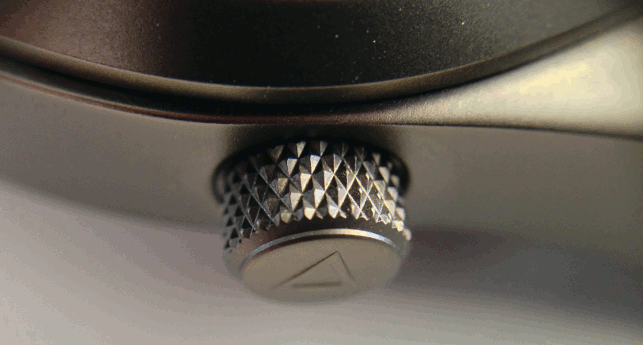
Fine detailing such as the knurling on the crowns
“The key thing really was to make them well enough to last and classically designed to not become outdated,” comments Brown.
A new member was brought onboard – designer Andy Russell who works with Elliot at Salad Creative. Having never designed a watch before Russell could bring fresh ideas to the table without being hampered by bias or preconceptions.
“We spoke a lot about what we wanted and also provided drawings on napkins and scribbles on bits of paper. Andy then did illustrations to give us a sense of what the watches could look like and then worked those up in Adobe Illustrator,” explains Brown.
They chose to start off with a small range, just 17 models in two case styles. These styles – Canford and Bloxworth – would come in various colours, finishes and interchangeable strap combinations.
Perfecting the crown
With Russell having worked on the aesthetics and the identity of the brand, Brown was working on the engineering side of things.
One feature that both he and Elliot wanted to perfect was the crown system. A crown is the winder on the side of a watch that is pulled out to set the time and date. Once set, it’s screwed down onto a single seal to close.
As they discovered at Animal, this offers the best possible seal when screwed down but that’s only if the customer remembers to keep it that way.
“People would go on holiday, adjust it to local time on the plane but then get distracted before they have a chance to screw the crown down again. On the other side they jump in the pool and their watch fills up with water,” describes Elliot.
So, they challenged themselves to engineer an elegant solution that would still make the watches waterproof to 200 metres. “We ended up redesigning the crown system to accommodate three separate seals on the crown stem that work without having to remember anything new,” explains Elliot.
“If the watch is working, then the crown is pushed in, and it’s automatically water resistant. It also just happens to work when the crown is pulled out as well.”
Another feature that they re-engineered from the norm was bolting down the case back as opposed to threading and screwing it down.
“Unlike the alternative screw-down case back, bolting it down means we are able to compress the anti shock elastomers surrounding the movement housing and the over sized seal to exactly the right pressure every time,” continues Elliot. “It gives every watch a perfect seal and ticks another box in our mission to build the toughest time pieces.”
Bucking the trend
In further pursuit of this mission they made two big decisions during the development process.
The first was to use a Swiss made quartz movement as opposed to mechanical. The simple reason is that it’s tough as well as elegant, durable and repairable.
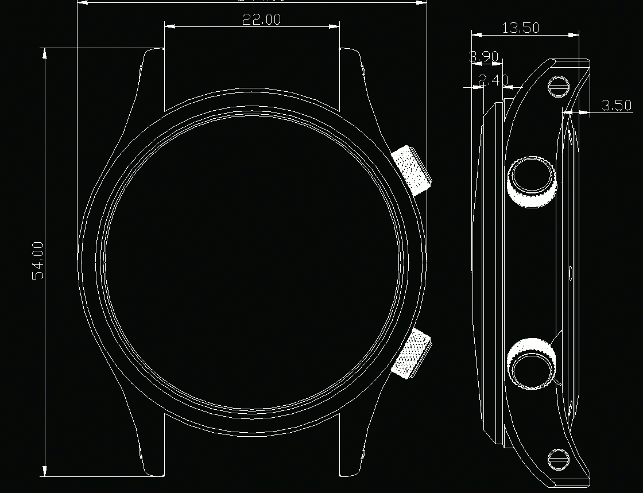
A drawing in Adobe Illustrator showing the dimensions of Canford
The second was to use a hardened and tempered mineral crystal lens as opposed to the industry norm of sapphire. Although sapphire resists scratching it can shatter whereas mineral crystal may scratch easier but it’s more resilient.
“To make sure the crystal is tough enough, we test it by dropping a 16.5kg ball bearing measuring 16mm across onto it from half a metre above the watch using an electromagnet to release it. The ball drops onto the crystal three times to give us total confidence that the hardening and tempering of the crystal reaches our standard,” says Elliot.
When it came to the final detailing of the watch, they spent hours perfecting the surfaces, finishes and shapes. Elliot says they’ve been accused of having OCD but they couldn’t help themselves.
This attention to detail can be found in things like the knurling on the crowns that make them easy to wind. Even the buckle on the strap is engraved with the brand logo and filled with luminous ink so that the watch is easy to find in the dark even if it’s upside down.
Working with the factory
Once the Illustrator files were complete they were sent to the factory in China and converted into accurate engineering drawings.
A period of sending these CAD files back and forth ensued to fine tune all the details.
One technical detail that the engineers at the factory helped Elliot Brown with was the achievement of the triple seal crown system. “We had to increase the amount of meat on the side of the case from our initial drawings to accommodate the three different seals but to also accommodate the movement housing inside,” says Elliot.
Brown admits that with such a tight timeframe the factory didn’t have an enormous amount of time to produce prototypes. In light of this they all worked really hard to ensure that the designs on screen were exactly as they’d hoped they’d be when produced.
“The factory has been really supportive. They have translated all of the little nuances we worked really hard on as well as all the tough technical detailing.
They did an amazing job in making that come to life for us,” comments Brown.
Testing, testing and more testing
But the factory didn’t only produce the watches they also agreed to subject them to a rigorous testing regime.
As well as various tests carried out on the straps and chronograph pushers, each watch is pressure tested twice during build up.
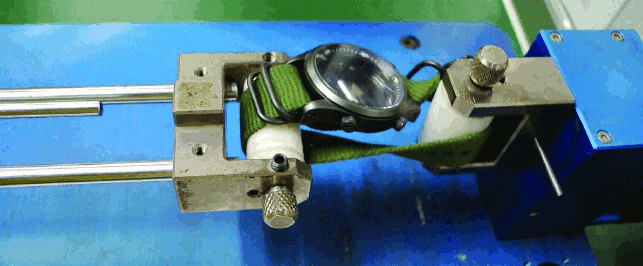
Each canvas strap is subjected to a torsion and tension test
Once it’s passed the 150m/1.5ATM air pressure test it then undergoes a wet test where it’s placed into a water vessel and the pressure is cranked up to an equivalent depth of 200m/20ATM for ten minutes.
“Straight after the wet pressure test we heat the watches up to 45 degrees celsius then drop some water on the face to test if any condensation forms inside. Only once they’ve passed do they progress to the next stage of testing and quality control,” explains Elliot.
Additional tests were carried out to the official ISO standard test of dropping the watch a metre onto a hard wood surface. Including the ball bearing test described earlier, batches are also subjected to a shock proofing test where a 3kg pendulum stainless steel hammer knocks the watch off a plinth into a catch net. “At the point where the hammer hits the watch we believe there is circa 5,000G being applied. It’s one hell of a hit and we haven’t had a watch fail that test yet,” says Elliot.
Launch day
Three years after that fateful coffee shop chat, Elliot Brown officially opened its doors in March 2013.
With a number of stockists secured, the company debuted its range at the inaugural London Watch Show in July.
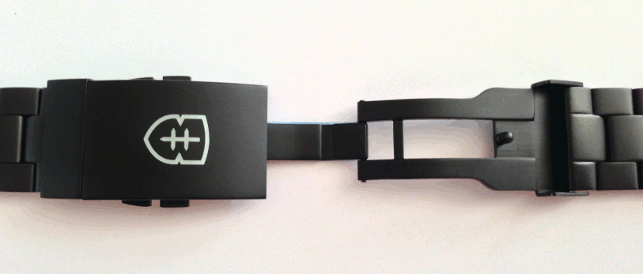
The buckle on the bracelets are engraved with the brand logo and filled with luminous ink to shine in the dark
The watches have been well received by peers and retailers, not least of all for the price (£325 to £600) which is deemed great value for the level of engineering and build quality.
Press reviews have also been favourable with T3 Magazine naming the Bloxworth as one of its top ten watches to buy in 2013 and industry magazine WatchPro awarding it the Watch of the Year 2013 Rising Star.
Elliot and Brown took a risk in following their guts but it looks to be paying off. They will keep improving their products if better materials, components or mechanisms turn up because for them it’s genuinely about producing the best product they can. They take a huge amount of pride in that, and rightly so.
How it all began
Back in the 80s Ian Elliot had lost too many watches than he dared count while surfing.
In a bid not to lose another he sat in front of a sewing machine and invented a velcro watch strap. With that design he co-founded the action sports lifestyle brand Animal in Poole, Dorset.
The brand went on to produce watches that would stand up to all the conditions Animal customers would subject them to snow, salt, deep water, mud and air pressure.
Watch maker Alex Brown joined the Animal team having turned down a job at Cartier to head up its watch department. “I think he was the only person at that time to ever have turned down a job at Cartier but he fancied a lifestyle working for a funky brand down in coastal Dorset and never looked back for 17 years,” says Elliot.
Elliot admits that Animal initially existed as a means of him pursuing his sporting ambitions as the brand would sponsor numerous athletes and events that he participated in from surfing to mountain biking.
“We used to give straps, clothing and watches away at these events. It was an affordable means of brand promotion that would get our products used and worn by core people.”
But things came unstuck when he decided to take the brand to the US. After five years of trying to make it work Elliot reluctantly sold Animal in 1999.
He went on to set up the branding agency Salad Creative in Poole where he has been for the past 12 years.
Meanwhile Brown remained at Animal, but he and Elliot stayed in touch, regularly meeting for coffee. About three years ago a spark flew and the idea for Elliot Brown was ignited.
The rest, as they say, is history.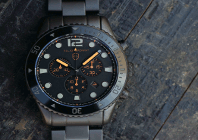
The making of a classic timepiece from design, development, testing and manufacture
Default


